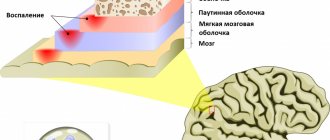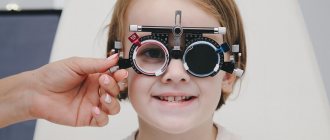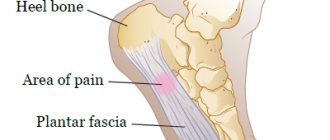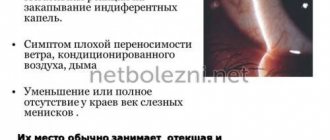Eye pain is a symptom of a serious illness!
Therefore, do not self-medicate, but consult a doctor. You can make an appointment at a time convenient for you.
Leave your phone number. The clinic administrator will call you back.
Make an appointment
Appointment with an ophthalmologist
from 750 rub.
We all experience eye pain at some point in time. Sometimes it goes away on its own, and sometimes it persists for a long time. Doctors at the Laser Eye Microsurgery Clinic on Maerchak warn that eye pain can be caused by serious diseases. Therefore, if you experience eye pain, consult a doctor.
Causes of eye pain
There are several serious diseases whose symptoms include pain inside the eye. Many of them require urgent treatment, so establishing the true cause of pain inside the eyes must occur quickly.
The main etiological factors that cause acute pain inside the eyeball are the following:
- Angle-closure glaucoma. The pathology is caused by a sharp increase in intraocular pressure due to improper circulation of ocular fluid. With this anomaly, pain can occur suddenly and increase at a high rate. In addition to pain in the eyeball, this condition is accompanied by visual disturbances - scotoma, rapid increase in myopia, changes in color vision, a feeling of strong pressure in the eyes, headache and nausea.
- An attack of ocular hypertension provoked by a violation of the circulation of the intraocular fluid. Increased pressure inside the eye worsens in the morning and can spontaneously subside in an upright position. In addition to discomfort, an increase in the vascular pattern on the conjunctiva is observed directly in the eye, and sometimes hemorrhage in the membrane of the eye.
- Increased intracranial pressure due to traumatic brain injury, hemorrhagic stroke, cerebral hematomas, meningitis and encephalitis, tumors and other pathologies. With this anomaly, patients complain of periodically increasing pain inside the eye. Symptoms increase when lying down, when coughing, sneezing, or other types of stress. Additionally, there is a slight decrease in visual acuity, which can progress with increased pain.
- Neuralgia of the trigeminal or supraorbital nerve. In such conditions, pain inside the eye is localized on one side and limited to the cheekbone, part of the nose with damage to the trigeminal nerve or the orbit of the eye, brow ridge and part of the forehead with supraorbital neuralgia. Additional symptoms are lacrimation on the affected side, increased pain when trigger points are irritated.
- Optic neuritis due to sinusitis, damage to the myelin sheath (sclerosis), inflammation of the orbit. The pathology is accompanied by pain inside the eyeball that intensifies when turning, a change in the perception of colors, a decrease in visual acuity and the appearance of spots in the visual field.
- Inflammation of the eyeball. The patient complains of acute constant pain inside the eye and increased body temperature. Visually visible swelling of the conjunctiva, redness of the eyelids, decreased vision on the affected side.
Pain syndrome inside the eye is also provoked by cluster headaches and migraines. Such anomalies are more common in women of fertile (childbearing) age. The pain in most cases is paroxysmal, intense, occurs suddenly, and lasts from several hours to several days. In addition to pain inside the eye, the condition is accompanied by lacrimation on the affected side, inflammation and redness of the cornea, general depression, attacks of irritability, intolerance to light, sounds, etc.
In isolated cases, behind the symptoms of inflammation of the eyeball, neuritis and neuralgia, glaucoma and other ophthalmological pathologies, another anomaly is hidden that is not related to the visual organs. Most often they are sinusitis, frontal sinusitis, gumboil, deep damage to the roots of teeth by caries.
Eyes hurt
My eyes hurt, what is the reason and what to do? To understand why your eyes hurt, you need to understand that your eyes hurt in diseases associated with pathological changes in both the eyes themselves and in general diseases of the body. To differentiate the cause of eye pain, it is necessary to pay attention to the accompanying symptoms. For example, the eyes and head often hurt at the same time, the eyes hurt against the background of high blood pressure, and pain in the eyes can also often be combined with redness of the eyes. These and other accompanying symptoms of eye pain will help make the correct diagnosis, choose the direction of treatment and answer the question: what to do? Let's try to figure out why your eyes hurt and what to do? Eye pain is a characteristic symptom of many eye diseases. A. Reasons why the eyes may hurt when the eyes themselves are diseased:
1. Keratitis - inflammation of the cornea 2. Uveitis - inflammation of the choroid 3. Glaucoma 4. Conjunctivitis 5. Eye injury 6. Foreign body of the conjunctiva or cornea 7. Incorrectly selected glasses 8. Incorrectly selected contact lenses 9. Uncorrected vision with presbyopia 10. Eyes hurt after welding
B. Reasons why eyes may hurt due to general diseases of the body:
1. Viral infection 2. Blood pressure disorders 3. Migraine 4. Increased intracranial pressure (ICP)
A. Causes of pain in the eyes when the eyes themselves are diseased:
1.
Keratitis
, or inflammation of the cornea, is always accompanied by pain in the eyes.
In addition to eye pain, keratitis is absolutely always accompanied by additional symptoms. The so-called “corneal syndrome” is characterized by the presence of lacrimation, redness of the pericorneal zone (around the cornea), blepharospasm (spasm of the eyelids) and, of course, pain in the eyes. The eyes hurt very much with keratitis. Treatment:
treatment is carried out only in a specialized ophthalmological institution.
It is impossible to cure keratitis yourself at home without consequences for vision. Local and general anti-inflammatory treatment is necessary in the form of parabulbar injections of antibiotics and, if necessary, corticosteroid drugs, placing anti-inflammatory ointment and drugs that improve corneal regeneration behind the eyelids. If there are signs of keratitis, you should immediately consult a doctor. 2. Uveitis
, or inflammation of the inner choroid of the eye.
The choroid of the eye has three sections, each of which can become inflamed separately or there can be a combined inflammation, which is called panuveitis. Inflammation of the iris, or iritis, inflammation of the middle part of the choroid, or iridocyclitis. always accompanied by very severe pain in the eyes. The pain is so severe that it is impossible to touch the eye. Associated symptoms include pericorneal injection and possible changes in the color of the iris and the clarity of the pattern. Interestingly, inflammation of the third part of the iris - the choroid - is never accompanied by pain in the eyes and choroiditis at the initial stage is often asymptomatic. This occurs due to the lack of sensory nerve fibers in the choroid. Treatment:
treatment of uveitis should only be carried out in a specialized ophthalmology department and, as a rule, this disease requires treatment in an eye hospital.
At home, it is impossible to cure uveitis on your own without damaging your vision. 3. Glaucoma
.
A common symptom of glaucoma is pain in the eye. The left eye hurts or the right eye hurts, the one in which there is increased intraocular pressure. Often, in addition to pain in the eyes, there is a feeling of pressure. “Pressure in the eyes” is how patients describe their sensations with glaucoma. Another characteristic sign of glaucoma, which can help to suspect the disease, is pain in half of the head, in the half in which the intraocular pressure is increased in the eye. A characteristic sign of glaucoma is that not the whole head hurts, but rather half the head on the side of the diseased eye. Treatment:
Treatment for glaucoma can be medication, laser or surgery.
Drops that reduce intraocular pressure, such as Travatan, Timolol, Betoptik, Xalatan, Azopt, Arutimol, Trusopt, are prescribed by a doctor depending on the degree of glaucoma, its stage and the strength of the increase in intraocular pressure. Along with drug treatment, laser treatment is a very promising method of reducing blood pressure. If there is no desired effect from drug and laser treatment, surgical treatment of glaucoma is prescribed. Pain in the eye goes away with a decrease in intraocular pressure to normal levels. Normally, intraocular pressure should be no more than 26 mm Hg. when measured with a Maklakov tonometer at any age of a person. 4. Conjunctivitis
is rare, but can also be accompanied by pain in the eyes, more precisely a burning sensation and a feeling of a foreign body.
A more precise definition of pain with conjunctivitis: discomfort in the eyes and pain in the eyes. The reasons for these sensations are swelling and disruption of the integrity of the epithelial layer of the eyelids and the eyeball - the conjunctiva. Along with the pain, there is redness of the eyes, discharge in the conjunctival cavity; with bacterial conjunctivitis, eyelashes stick together in the morning. Treatment:
treatment is carried out depending on the type of pathogen - antiviral or antibacterial.
Tobrex, Tobradex, Maxitrol, Vitabact, as a rule, allow you to cope with conjunctivitis and eliminate eye pain. Oftalmoferon will be useful for pain from viral conjunctivitis. 5. Eye
trauma , even microtrauma, causes pain in the eyes.
In case of injury, the epithelium of the cornea or conjunctiva is most often damaged, which leads to irritation of sensitive nerve fibers and, as a result, eye pain. More serious injuries with rupture of the membranes always cause severe pain in the eyes. Treatment:
Drugs that improve tissue regeneration, such as Solcoseryl, Actovegin, Citral. To prevent secondary infection, it is recommended to use Tobrex, Maxitrol, Albucid 20%, chloramphenicol 0.25%.
6.
A foreign body in the conjunctiva or cornea
is the most common cause of eye pain.
The cornea is the most sensitive part of the body. Getting a hair or even a speck of dust into the eye causes discomfort and pain in the eye. A foreign body entering the conjunctival cavity disrupts the integrity of the epithelium and has the same consequences as an eye injury. The intensity of pain depends on the volume of the foreign body and location. Thus, the entry of an eyelash into the conjunctival cavity causes moderate pain and a feeling of a foreign body. A foreign body entering the cornea causes very severe pain. Treatment:
If the foreign body is visible and easily accessible, you can try to remove it yourself with a cotton swab or rinse the eye with warm water.
Then it is necessary to apply treatment, the same as for an eye injury. If you cannot remove the foreign body yourself, you must contact the Eye Emergency Center to receive specialized assistance. The eye emergency room is open 24 hours a day, so you should contact us at any time at any time. And the sooner help is provided, the better the prospects for treatment. Address of the eye emergency room in Krasnoyarsk: Krasnoyarsk city, st. Nikitina, 1 "B". 7. Incorrectly chosen glasses
are also a common reason why the eyes hurt, as if they are pressing.
The main errors in the selection of glasses are incorrectly measured interpupillary distance or diopters of glasses that are larger than they are necessary for the state of refraction. Such errors lead to excessive refractive error or tension in the extraocular muscles and, as a result, to headaches or painful sensations in the eyes. Pain when the eyes “seem to be pressing” excludes an inflammatory process of the eye or injury. This pain is typical of incorrectly chosen glasses or general health problems. Treatment:
double-check purchased glasses with a competent ophthalmologist.
Perform laser vision correction and eliminate the need for glasses. 8. Incorrectly fitted contact lenses
often cause eye pain.
Contact lenses require individual selection, since the radius of curvature of the cornea is different for all people, and even in two eyes of one person, the radius of curvature of the cornea can vary greatly. Therefore, when selecting contact lenses, it is necessary to focus on the individual characteristics of each eye, and not just on the diopter of the lenses. It is recommended to select lenses only in specialized clinics. An incorrectly selected lens acts as a foreign body, injuring the cornea of the eye, causing pain and inflammation of the eye. Treatment:
it is necessary to abandon contact lenses for a period of at least two weeks to restore the integrity of the cornea and select contact lenses from an experienced contact specialist.
To eliminate pain from contact lenses, laser vision correction is possible. 9. Uncorrected vision with presbyopia
leads to eye pain, especially if a person is forced to read for a long time or work nearby, for example, on a computer.
Accommodation allows a person to see at a close distance from the eye, but with age this process is disrupted, presbyopia develops, and near glasses are needed to compensate for impaired accommodation. If you try to strain your eyes when the possibility of accommodation is lost, then eye fatigue occurs and your eyes begin to hurt. Treatment:
it is necessary to select glasses for working at close range in accordance with age and existing refraction.
10. Eyes hurt after welding
due to radiation burn of the cornea.
As they say, “I’ve picked up welding bunnies,” what should I do? The welding arc used to weld two metals emits infrared radiation and ultraviolet radiation of enormous power. During welding work, eyes must be protected with special glass that limits exposure to infrared and UV radiation. If safety precautions are violated and the eye is openly exposed to radiation, a burn to the cornea occurs. Retinal damage may also occur. But pain in the eye after welding occurs precisely because of a burn to the cornea. Therefore, all measures to relieve pain after welding should be aimed primarily at treating the cornea. Treatment:
Rinse eyes with cool water.
To regenerate the cornea, it is necessary to use drugs such as Solcoseryl, Korneregel, Citral, Oftagel, Balarpan, Khilozar-komod. For the prevention of secondary infection: “Tobrex”, “Maxitrol”, “Albucid 20%”, “Levomycetin 0.25%”. If the pain is very severe, you can drop novocaine or lidocaine into your eyes. But, if the condition allows, it is better not to do this, since anesthesia causes swelling of the cornea and increases healing time. You can take any general action analyst, “Ibrufen” or “Analgin”, “Diclofenac” (Voltaren), or “Indomethacin”. It is better to be in a darkened room and with your eyes closed for several hours. B. Reasons why the eyes may hurt due to general diseases of the body:
1.
Viral infection
is very often accompanied by pain in the eyes.
If you experience pain behind your eyeballs when moving your eyes, then most likely you have an acute viral infection in your body. Coronavirus infection in the body is no exception. Coronavirus, like any other viral infection, leads to pain behind the eyes, especially in the initial stages of the disease. Eye pain with coronavirus is associated specifically with a viral infection in the body. Treatment:
To eliminate pain in the eyes due to a viral infection, general antiviral treatment is necessary from an appropriate specialist.
Local eye treatment is not required in this case. 2. Blood pressure disorders
.
Changes in blood pressure, both upward (hypertension or hypertension), and downward (hypotension), are accompanied by headache and frequent irradiation of pain to the orbital and eye areas. Treatment:
in case of a sharp and significant change in blood pressure, you must take a horizontal position - lie down, call a doctor.
With high blood pressure, the head should be higher than the body, with hypotension at body level. Compensatory therapy and equalization of blood pressure will lead to the disappearance of eye pain. 3. Migraine
leads in most cases to pressing pain behind the eyes.
Migraine is accompanied by loss of visual fields and headache. Eye pain is also a symptomatic sign of migraine. Treatment:
elimination of migraine leads to the disappearance of pain in the eyes.
4. Increased intracranial pressure
is accompanied by headaches and painful sensations in the eyes.
The diagnosis is made on the basis of fundus ophthalmoscopy and accompanying symptoms characteristic of increased ICP. Treatment:
Elimination of the causes of increased intracranial pressure leads to the absence of pain in the eyes.
You will probably find it interesting and useful: 1. Red eyes. Why and what to do?
2.
Why do my eyes water?
Causes and treatment. 3.
How to restore vision
08/22/2021
author Natalya Yatsinova
Diagnosis of pain inside the eye
To diagnose eye pain, a comprehensive ophthalmological examination is performed. Before it, instillation of analgesics is recommended, since pain leads to blepharospasm, which complicates examination. After this, visual and instrumental studies are carried out:
- visometry - measuring visual acuity using tables;
- non-contact tonometry - measurement to detect increased pressure inside the eyes;
- biomicroscopy - examination of the front side of the eyeball using a slit lamp, revealing corneal defects, inflammation and other pathologies;
- ophthalmoscopy - measurement of the transparency of the optical media of the eye and visual examination of the retina for pathologies;
- Ultrasound of the eyeball is a wave diagnostic method that helps diagnose developmental anomalies and defects of all eye structures;
- X-ray of the eye is a radiation diagnostic method that detects foreign bodies and defects of bone structures in the orbital area.
If a secondary nature of pain is suspected, general studies are carried out: blood and urine tests, tests for specific and nonspecific microflora, functional diagnostics.
Dry eye syndrome
Dry eye syndrome is the scourge of our time. Office workers are usually susceptible to it. Three factors contribute to the development of the disease:
- Fluorescent lighting.
- Air conditioned indoors.
- Working at the computer for a long time.
The above factors contribute to disruption of the process of natural hydration of the eyeball. In this case, the violation itself is caused by:
1. High degrees of visual stress. 2. Rare blinking caused by working at the monitor. 3. Immobility of the eyeball.
In a closed room, with dry, air-conditioned air, with electric, often insufficient or incorrect lighting, all the prerequisites are created that lead to the fact that the production of tear fluid is quickly disrupted. The properties and composition of the tear film, which covers the anterior segment of the eyeball, change. It is no longer able to protect the eye from dryness and microscopic dust particles.
Treatment
The choice of treatment methods depends on the causes of unpleasant symptoms. Tactics can vary significantly in patients experiencing similar symptoms, but having a different list of pathologies.
See what treatment for eye pain is used for various diseases in the table below.
| Disease | Conservative therapy | Surgical/minimally invasive intervention |
| Glaucoma | Instillation of miotic drugs within the first 2 hours after admission to the hospital. Analgesics intramuscularly (diphenhydramine, promedol, aminazine). Intravenous administration of mannitol and glycerol to equalize IOP. | Iridectomy is a laser operation through which the doctor creates an opening between the anterior and posterior chambers of the eye to restore the circulation of intraocular fluid. |
| Ophthalmohypertension | Antihypertensive drugs: ● systemic diuretics; ● inhibitors of VGZ synthesis; ● beta-blockers. Additionally, combined analgesics are used. | Not required. |
| Increased intracranial pressure | Pressure control methods: ● taking diuretics; ● compliance with the drinking regime; ● diet; ● physiotherapy; ● manual therapy. | Shunting is the implantation of shunts (tubes) to drain excess fluid (CSF) from the skull. |
| Optic or trigeminal neuralgia | To relieve pain, a complex of anti-inflammatory, anticonvulsant, sedatives and antidepressants is used. Additionally, physiotherapy, acupuncture, and electrical stimulation are used. | Microsurgical intervention aimed at eliminating compression of nerves. |
| Optic neuritis | Prescribed drugs to eliminate the causes of neuritis: ● antibiotics for bacterial infections; ● antiviral agents for viral inflammation (herpes). Additionally, systemic anti-inflammatory drugs are prescribed, as well as glucocorticosteroids (administered retrobulbarly, that is, inside the eye). | Not applicable. |
| Inflammation of the eyeball | A course of antibiotics and anti-inflammatory drugs of systemic and local action is prescribed. To increase the effectiveness of treatment of inflammation of the eyeball, hormonal drugs are used - prednisolone, hydrocortisone. | Used only in the presence of abscesses. The intervention is carried out in an outpatient setting. The doctor opens the purulent cavity, washes it, and applies a bandage. |
| Cluster headaches and migraines | Therapy is aimed at eliminating headaches and restoring normal vascular tone. Ergotamines, triptans, prescription analgesics, anesthetics, and antiepileptic drugs are used. To improve the condition, physiotherapy and exercise therapy are used. | Not applicable. |
How to deal with sand in your eyes in the morning?
This problem is most common in older people. It is encountered by patients who spend a lot of time in front of a monitor screen. Lack of sleep also negatively affects the condition of the eyes, since the mucous membrane does not have time to fully recover during a short period of sleep.
The feeling of “sand” in the eyes in the morning can be felt by girls and women who forget to wash off their decorative cosmetics before going to bed and fall asleep right with it on.
If morning “sand” appears in the eyes for a long time and frequently, you should consult an ophthalmologist. This may be a symptom of more serious illnesses.
Prevention of eye pain
There are no specific uniform measures to prevent eye pain, since the causes of its occurrence are diverse. To reduce the risk of their occurrence, ophthalmologists advise regular follow-up with them, as well as with doctors of other specializations. The risk of abnormalities that provoke intraocular pain can be reduced by following the general principles of a healthy lifestyle, personal hygiene, and visual hygiene:
- periodically give your eyes rest;
- Use eye protection when working with chemicals, working in contaminated areas or in bright light;
- systematically perform eye exercises;
- use prescription glasses for working with documents and watching TV if you have visual impairments;
- monitor the light level when working with documents, etc.
Patients of any age should consult a doctor immediately after the first unpleasant symptoms appear. This will allow the ophthalmologist to detect the source of the malaise in time and eliminate the problem at an early stage.
Symptoms
The main symptom is pain in the eyes. Cutting is almost always accompanied by a whole range of symptoms, which includes:
- Vasodilation
- Redness of the mucous membrane
- Increased sensitivity to bright light
- Peeling skin around the eyes or on the eyelids
- Itching of varying intensity
- Increased lacrimation
- Discharge of pus along with tears
- Swelling of the skin around the eyes
- Pain and discomfort
- Deterioration of vision
By studying the symptoms, the doctor will be able to select appropriate diagnostic methods. The presence of pain with increased lacrimation indicates an allergic reaction or eye fatigue, the presence of an acute respiratory viral infection, or inflammation of the ciliary edges or conjunctiva.
You may need to consult a doctor of another specialty, for example, an allergist.
Pain with a feeling of sand in the eyes
If there is no dry eye syndrome, symptoms may indicate incorrectly selected contact optics. Sensations occur when there is insufficient supply of oxygen and nutrients to the surface of the cornea. Most modern models of contact lenses have high oxygen permeability. Therefore, problems with mucosal nutrition arise only when vision correctors are used incorrectly.
Stinging in the eyes and tearing
Symptoms are caused by a sudden change in temperature. A striking example is the increased production of tear fluid when a person enters a warm room from a cold street.
Watery eyes are provoked by severe frosts or hot weather, dry climates, and exposure to smoke. The development factor is prolonged exposure to direct sunlight on the retina. These are temporary and relatively harmless cramps.
Sometimes pain in the eyes and tearing is caused by a foreign body. Care must be taken to ensure that it leaves the mucous membrane as quickly as possible. In this case, the lacrimal glands begin to produce a larger volume of fluids, which help the body remove excess particles.
Which doctor will help with pain in the eyes?
The symptom is the responsibility of an ophthalmologist, who conducts an examination and selects diagnostic methods. He finds out why it hurts the eyes, determines the exact causes and treatment.
How to quickly relieve tired eyes
During the break, perform light eye exercises:
- Look into the distance for 20 seconds, focus on an object that is located about 20 steps away from you;
- Close your eyes and make four rotations with your eyeballs - first clockwise, then counterclockwise;
- Without opening your eyelids, move your eyes up and down;
- Complete the exercise by blinking frequently for 30 seconds. The gaze is directed forward.
To consolidate the effect, drip your eyes with moisturizing drops selected by an ophthalmologist. Do not self-medicate, be sure to seek help from a specialist - moisturizing drops come in different viscosities, they can have a therapeutic effect, or they can simply wet the surface of the eye. Only an ophthalmologist will determine what exactly your vision needs and select the necessary remedy.
Sign up for a free vision test
By the way, gymnastics also requires prior consultation with a doctor. Make sure you have no contraindications. An ophthalmologist can also recommend other types of gymnastics.










